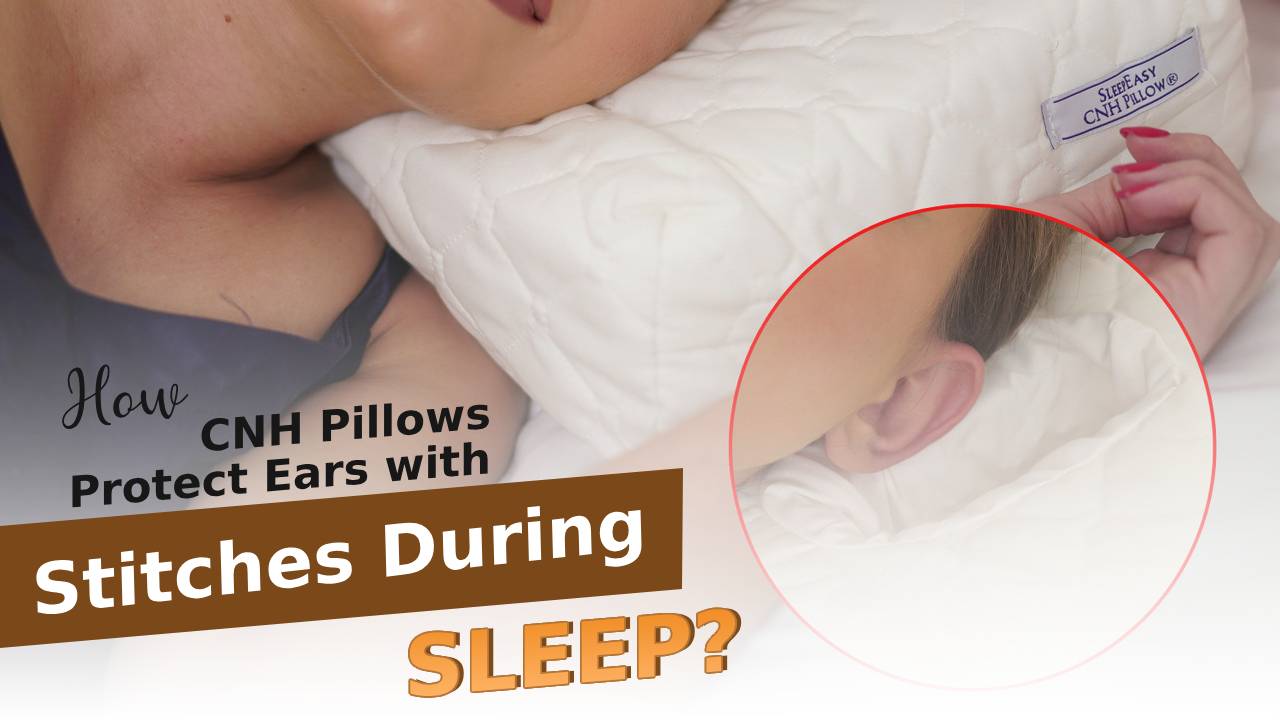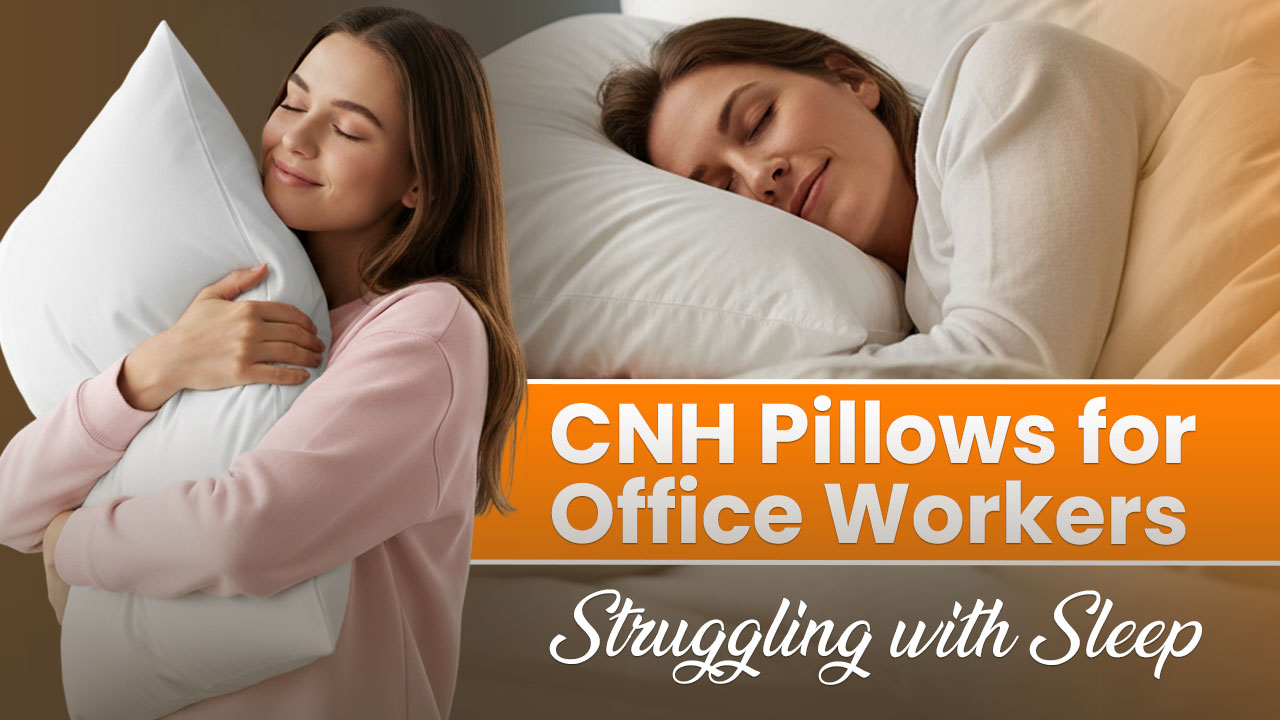Role of Pillows in Managing Insomnia for Seniors
Dec 21st 2024

The role of pillows in managing insomnia for seniors is to improve sleep quality by providing proper neck and spine alignment, reducing pain, enhancing relaxation, supporting breathing, and regulating temperature, which together help older adults fall asleep faster and stay asleep longer.
Why the Right Pillow Matters in Managing Insomnia for Seniors
Insomnia is one of the most common sleep disorders, and it becomes increasingly prevalent among older adults due to age-related changes in sleep patterns. Difficulty falling asleep, frequent awakenings, or waking too early can severely affect quality of life—causing fatigue, mood swings, and long-term health concerns. While many remedies exist, an often overlooked yet highly effective solution is choosing the right pillow. A supportive sleeping pillow or bed pillow designed for seniors can improve spinal alignment, relieve pressure points, and promote relaxation, making it easier to manage insomnia and achieve restorative sleep.
The Role of Pillows in Sleep Quality
Pillows are not just accessories; they are essential tools for maintaining healthy sleep hygiene and promoting restorative rest. The right sleeping pillow provides balanced support for the head, neck, and shoulders, ensuring proper spinal alignment throughout the night. This alignment helps prevent common sleep disruptors such as neck pain, morning headaches, and muscle stiffness—issues that frequently contribute to insomnia in older adults.
For seniors in particular, choosing a bed pillow tailored to their unique needs can transform sleep quality. Factors such as pillow firmness, filling material, loft height, and ergonomic design directly influence comfort and support. A memory foam or latex pillow may provide pressure relief and durability, while breathable, hypoallergenic covers help regulate temperature and reduce irritation. By selecting a pillow designed for their sleep position and health requirements, older adults can create an optimal sleep environment that supports relaxation, minimizes discomfort, and improves overall sleep efficiency.
Choosing the Right Sleeping Pillow
Finding the right pillow may seem overwhelming with so many options available, but focusing on personal sleep needs, health conditions, and comfort preferences makes the process much easier. For seniors managing insomnia, the right choice can transform sleep quality by improving spinal alignment, reducing pain, and enhancing relaxation. Here are the key considerations:
Pillow Material
The filling of a pillow plays a vital role in both comfort and durability:
- Memory Foam Pillows – Contour naturally to the head and neck, offering customized support that helps relieve pressure points.
- Latex Pillows – Firm, hypoallergenic, and highly durable, making them ideal for seniors with allergies or sensitivity to dust mites.
- Down or Feather Pillows – Luxurious and soft, but often lacking in consistent support for the neck and shoulders.
- Polyester (Microfiber) Pillows – Lightweight and affordable, though they flatten quickly and may need more frequent replacement.
For older adults prone to allergies or respiratory conditions, hypoallergenic pillows with antimicrobial protection are the safest choice.
Firmness Level by Sleeping Position
The best pillow firmness depends largely on sleep posture, which affects spine and neck alignment:
- Back Sleepers – A medium-firm pillow maintains the natural curve of the neck without pushing the head forward.
- Side Sleepers – A firmer, higher-loft pillow fills the gap between the shoulder and ear, preventing strain and misalignment.
- Stomach Sleepers – A soft, flat pillow reduces neck twisting and minimizes strain on the cervical spine.
By matching pillow firmness to sleep style, seniors can significantly reduce discomfort and wake up more refreshed.
Pillow Shape and Design
Specialty pillow designs cater to common sleep concerns among older adults:
- Contour Pillows – Ergonomically shaped to support the natural curve of the neck, easing stiffness and neck pain.
- Wedge Pillows – Elevate the upper body, making them effective for seniors with acid reflux, snoring, or mild sleep apnea.
- Body Pillows – Offer full-body support and promote proper hip, back, and shoulder alignment—especially helpful for side sleepers.
The Importance of Pillow Covers
Often overlooked, pillow covers play a direct role in both comfort and hygiene:
- Protect Against Allergens – Shield the pillow from dust mites, bacteria, and skin irritants.
- Extend Pillow Lifespan – Keep pillows cleaner and maintain their structure for longer.
- Promote Cooler Sleep – Breathable, hypoallergenic covers regulate temperature, reducing night sweats and irritation.
For seniors with insomnia, investing in high-quality, washable pillow covers ensures a cleaner, cooler, and healthier sleep surface.
Your Best Sleep Awaits: Transform Nights with SleepEasy Pillow!
Shop NowHow Pillows Help Address Insomnia in Seniors
The right pillows and pillow covers play a vital role in managing insomnia for older adults by addressing both physical and environmental sleep challenges.
1. Relieving Physical Discomfort
Chronic pain conditions such as arthritis, shoulder tension, or neck stiffness are common among seniors. Orthopedic or memory foam pillows distribute weight evenly, reduce pressure points, and support natural spinal alignment—making it easier to drift into uninterrupted sleep.
2. Encouraging Relaxation and Stress Relief
A well-designed sleeping pillow creates a calm, cozy environment that promotes relaxation. For seniors experiencing anxiety or stress-related insomnia, memory foam, latex, or plush down pillows provide a soothing feel that reduces restlessness and supports longer, deeper sleep cycles.
3. Supporting Breathing and Airflow
Elevating the head with a wedge or contour pillow improves airflow, reduces snoring, and helps alleviate sleep apnea symptoms. Improved oxygen circulation enhances sleep quality, ensuring seniors wake up feeling refreshed rather than fatigued.
4. Regulating Body Temperature
Temperature fluctuations at night often trigger insomnia. Cooling gel pillows, breathable latex, and hypoallergenic pillow covers regulate body heat and wick away moisture, preventing overheating and creating a consistently comfortable sleep environment.
Optimized Takeaway:
By relieving pain, calming the body, improving breathing, and maintaining a balanced temperature, pillows become more than just comfort items—they are essential tools for seniors managing insomnia and achieving restorative sleep.
Creating the Perfect Sleep Environment
While pillows play a vital role in managing insomnia for seniors, they work best when combined with a holistic sleep environment. Optimizing your bedroom setup can make falling asleep easier and help you stay asleep throughout the night.
- Invest in a Supportive Mattress: A high-quality mattress that aligns with your pillow ensures proper spinal support, reduces pressure points, and enhances overall sleep comfort.
- Maintain a Dark and Quiet Bedroom: Use blackout curtains to block light and consider white noise machines or calming sounds to eliminate disruptions that commonly disturb older adults’ sleep.
- Establish a Consistent Sleep Routine: Going to bed and waking up at the same time every day helps regulate your circadian rhythm, making it easier to manage insomnia naturally.
- Reduce Blue Light Exposure Before Bed: Limiting screen time and avoiding phones or tablets in the evening supports melatonin production, allowing the body to transition smoothly into restorative sleep.
By combining the right pillow with a well-structured sleep environment, seniors can significantly improve sleep quality, reduce insomnia symptoms, and wake up feeling refreshed.
Transform the Way You Sleep: Try the SleepEasy Pillow Now!
Shop Now
When to Replace Your Pillow for Better Sleep
Many people—especially older adults—continue using pillows long past their recommended lifespan. However, old or worn-out pillows can harbor dust mites, allergens, and bacteria, while also losing their supportive properties. This can lead to neck pain, poor spinal alignment, and restless nights.
Sleep experts recommend replacing pillows every 1–2 years, or sooner if you notice:
- Lumps, clumps, or uneven filling
- Loss of shape or firmness
- Increased allergies or morning congestion
- Discomfort in your neck, shoulders, or back
Switching to a new supportive pillow not only improves your comfort but also promotes better posture, deeper sleep, and overall health.
Why Choose SleepEasy CNH Pillows?
At SleepEasy CNH Pillows, we believe that great sleep starts with the right pillow. Our collection is designed to meet a wide range of sleep needs with a focus on comfort, durability, and advanced support.
- ✔ Memory Foam Pillows – Contour to your head and neck for personalized support
- ✔ Hypoallergenic Pillows – Reduce exposure to allergens for sensitive sleepers
- ✔ Orthopedic Pillows – Ideal for people with chronic neck pain or posture issues
- ✔ Breathable, Washable Covers – Luxurious design for hygiene and long-lasting freshness
Crafted with premium materials and ergonomic designs, SleepEasy CNH Pillows ensure:
- Proper neck and spine alignment
- Pressure relief for side, back, and stomach sleepers
- Long-term durability without flattening
Sleep better, live better – with SleepEasy CNH Pillows, your trusted partner in rest.
Final Thoughts
For seniors and older adults dealing with insomnia, choosing the right sleeping pillow can truly transform nightly rest. A supportive pillow not only reduces physical discomfort but also promotes relaxation, proper spinal alignment, and healthier breathing patterns—all essential for deep, restorative sleep.
Don’t overlook the role of a breathable, hypoallergenic pillow cover in maintaining hygiene, comfort, and allergy prevention. Small adjustments in your sleep environment, such as upgrading to a high-quality orthopedic or memory foam pillow, can deliver noticeable improvements in sleep quality, mood, and overall well-being.
If you or a loved one are struggling with restless nights, start by reassessing your bedding essentials. Remember, better sleep often begins with the right pillow—an investment in health, comfort, and long-term quality of life. With the proper pillow support, restful nights and sweet dreams are well within reach.
Frequently Asked Questions
How does a pillow help with insomnia?
A supportive pillow promotes proper spinal alignment by cradling the head, neck, and shoulders. This reduces tossing and turning, eases muscle tension, and creates a more comfortable sleep environment. For people with insomnia, using the right pillow can encourage relaxation and improve overall sleep quality.
What type of pillow is best for older adults?
Older adults often benefit from pillows that reduce pressure points and support joints. Memory foam pillows, latex pillows, and ergonomic contour pillows are popular options because they adapt to the body’s shape, relieve stiffness, and enhance blood circulation during sleep.
How often should pillows be replaced?
On average, pillows should be replaced every 1–2 years to maintain proper support and hygiene. Over time, pillows accumulate dust mites, allergens, and sweat, which can trigger allergies and disrupt sleep. If your pillow feels lumpy, flat, or causes neck pain, it’s time for a replacement.
Can pillow covers improve sleep quality?
Yes, breathable, hypoallergenic pillow covers made of cotton or bamboo fabric enhance airflow and reduce heat buildup. They also protect against dust mites, bacteria, and allergens, helping you maintain a cleaner sleep surface and a more restful night’s sleep.
Are wedge pillows good for insomnia?
Wedge pillows are especially helpful for people who experience insomnia due to acid reflux, sleep apnea, or breathing problems. By elevating the upper body, wedge pillows reduce nighttime reflux, ease snoring, and improve airflow, which contributes to deeper, uninterrupted sleep.
How do I clean my pillows?
Cleaning methods depend on the pillow material. Many synthetic and down pillows can be machine-washed on a gentle cycle, while memory foam pillows require spot cleaning. Always use pillow protectors and wash pillowcases weekly to keep your sleep environment fresh and hygienic.
What is the best sleep position for insomnia?
Side sleeping is generally recommended because it opens airways, reduces snoring, and supports healthy breathing. However, the best position varies by individual. A high-quality pillow should maintain neutral spinal alignment whether you sleep on your back, side, or stomach.
Can pillows help with neck pain?
Absolutely. Orthopedic and cervical contour pillows are designed to align the spine and reduce strain on the neck muscles. Using the right pillow can significantly ease stiffness, tension headaches, and chronic neck pain, especially for side and back sleepers.
Are firm or soft pillows better for older adults?
The ideal pillow firmness depends on sleep position. Side sleepers usually need firm pillows to fill the gap between the neck and shoulder, while back sleepers often prefer medium-firm support to keep the head aligned without strain. Stomach sleepers typically benefit from softer pillows.
Do specialty pillows really work?
Yes, specialty pillows such as wedge pillows, body pillows, and pregnancy pillows are designed for specific needs. They help with conditions like acid reflux, sciatica, sleep apnea, or back pain. For targeted comfort, these pillows can make a noticeable difference in sleep quality.



